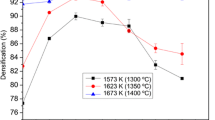Abstract
This work has successfully achieved high density (99.9%) polycrystalline LiTaO3. The keys to the high density without cracking were the use of LiF-assisted densification to maintain fine grain size as well as the presence of secondary lithium aluminate phases as grain growth inhibitors. The average grain size of the hot pressed polycrystalline LiTaO3 is less than 5 μm, limiting residual stresses caused by the anisotropic thermal expansion. Dilatometry results clearly indicate liquid phase sintering via the added LiF sintering aid. Efficient liquid phase sintering allows densification during low temperature hot pressing. Electron microscopy confirmed the high-density microstructure. Rietveld analysis of neutron diffraction data revealed the presence of LiAlO2 and LiAl5O8 minority phases and negligible substitutional defect incorporation in LiTaO3.






Similar content being viewed by others
References
A.M. Glass, Dielectric, thermal, and pyroelectric properties of ferroelectric LiTaO3. Phys. Rev. 172(2), 564–571 (1968)
V. Gopalan, K. L. Schepler, V. Dielorf, I. Biaggio, in The Handbook of Photonics, ed. by M.C. Gupta, J. Ballato. Chapter 6: Ferroelectric Materials, 2nd edn (CRC Press, 2006), pp. 1–53
C.B. Roundy, R.L. Byer, Sensitive LiTaO3 pyroelectric detector. J. Appl. Phys. 44, 929–931 (1973)
Y. Cho, K. Fujimoto, Y. Hiranaga, Y. Wagatsuma, A. Onoe, K. Terabe, K. Kitamura, Tbit/inch2 ferroelectric data storage based on scanning nonlinear dielectric microscopy. Appl. Phys. Lett. 81(23), 4401–4403 (2002)
V. Gopalan, V. Dierolf, D.A. Scrymgeour, Defect-domain wall interactions in trigonal ferroelectrics. Annu. Rev. Mater. Res. 2007(37), 449–489 (2007)
L. Tian, V. Gopalan, L. Galambos, Domain reversal in stoichiometric LiTaO3 prepared by vapor transport equilibration. Appl. Phys. Lett. 85(19), 4445–4447 (2004)
P.T. Brown, G.W. Ross, R.W. Eason, A.R. Pogosyan, Control of domain structures in lithium tantalate using interferometric optical patterning. Opt. Commun. 163, 310–316 (1999)
Y. Saito, H. Takao, T. Tani, T. Nonoyama, K. Takatori, T. Homma, T. Nagaya, M. Nakamura, Lead-free piezoceramics. Nature 432(4), 84–87 (2004)
J. Rödel, W. Jo, K.T.P. Seifert, E.-M. Anton, T. Granzow, D. Damjanovic, Perspective on the development of lead-free piezoceramics. J. Am. Ceram. Soc. 92(6), 1153–1177 (2009)
S.O. Leontsev, R.E. Eitel, Progress in engineering high strain lead-free piezoelectric ceramics. Sci. Technol. Adv. Mater. 11, 044302 (2010)
M. Katz, R.K. Route, D.S. Hum, K.R. Parameswaran, G.D. Miller, M.M. Fejer, Vapor-transport equilibrated near-stoichiometric lithium tantalate for frequency-conversion applications. Opt. Lett. 29(15), 1775–1777 (2004)
R.T. Smith, F.S. Welsh, Temperature dependence of the elastic, piezoelectric, and dielectric constants of lithium tantalate and lithium niobate. J. Appl. Phys. 42(6), 2219–2230 (1971)
A. Huanosta, A.R. West, The electrical properties of ferroelectric LiTaO3 and its solid solutions. J. Appl. Phys. 61, 5386 (1987)
Z.G. Ye, R. Von Der Mühll, J. Ravez, in IEEE 7th International Symposium on Applications of Ferroelectrics. Sintering Mechanism of LiTaO3 Ceramics by the Addition of Lithium and Magnesium Fluorides (Champaign, IL, 1990), pp. 566–569
S. Shimada, K. Kodaira, T. Matsushita, Sintering LiTaO3 and KTaO3 with the aid of manganese oxide. J. Mater. Sci. 19, 1385–1390 (1984)
Y. Torii, T. Sekiya, T. Yamamoto, K. Koyabashi, Y. Abe, Preparation and properties of LiTaO3-based solid solutions with cation vacancies. Mat. Res. Bull. 18, 1569–1574 (1983)
S. Kawakami, A. Tsuzuki, T. Sekiya, T. Ishikuro, M. Masuda, Y. Torii, Structural and dielectric properties in the system LiTaO3-WO3. Mater. Res. Bull. 20, 1435 (1985)
A. Elouadi, M. Zriouil, J. Ravez, P. Hagenmuller, Some new non-stoichiometric phases appearing close to LiTaO3 in the ternary system Li2O-Ta2O5-(TiO2)2. Mat. Res. Bull. 16, 1099–1106 (1981)
J.P. Bonnet, J. Ravez, G.T. Joo, P. Hagenmuller, Correlations between sintering conditions and microstructure in ceramics of composition Li0.80Mg0.20 (Ta0.80Ti0.20)O3. J. Mater. Res. 3(2), 387–391 (1988)
B.S. Chiou, Y.T. Lin, J.G. Duh, Sintering behavior and dielectric characteristics of LiTaO3 with the addition of (Mg2 + TiO2). Mater. Chem. Phys. 28, 51 (1991)
C.-F. Chen, A. Llobert, G.L. Brennecka, R.T. Forsyth, D.R. Guidry, P.A. Papin, R.J. McCabe, Powder synthesis and hot-pressing of a LiTaO3 ceramic. J. Am. Ceram. Soc. 95(9), 2820–2826 (2012)
FIZ Karlsruhe ICSD collection code 9537, structure form LiTaO3
FIZ Karlsruhe ICSD collection code 23815, structure form LiAlO2
FIZ Karlsruhe ICSD collection code 10480, structure form LiAl5O8
T. Yang, Y. Liu, L. Ahang, M. Hu, Q. Yang, Z. Huang, M. Fang, Powder synthesis and properties of LiTaO3 ceramics. Adv. Powder Technol. 25(3), 933–936 (2014)
Acknowledgements
The authors would like to thank Robert Reinovsky, program manager of LANL ADX Office C3 Science Campaign, for the funding support. Los Alamos National Laboratory is operated by Los Alamos National Security LLC under DOE Contract DE-AC52-06NA25396. Sandia National Laboratories is a multiprogram laboratory operated by Sandia Corporation, a wholly owned subsidiary of Lockheed Martin Company, for the United States Department of Energy’s National Nuclear Security Administration under contract DE-AC04-94AL85000.
Author information
Authors and Affiliations
Corresponding author
Rights and permissions
About this article
Cite this article
Chen, CF., Brennecka, G.L., King, G. et al. Processing of crack-free high density polycrystalline LiTaO3 ceramics. J Mater Sci: Mater Electron 28, 3725–3732 (2017). https://doi.org/10.1007/s10854-016-5980-5
Received:
Accepted:
Published:
Issue Date:
DOI: https://doi.org/10.1007/s10854-016-5980-5




